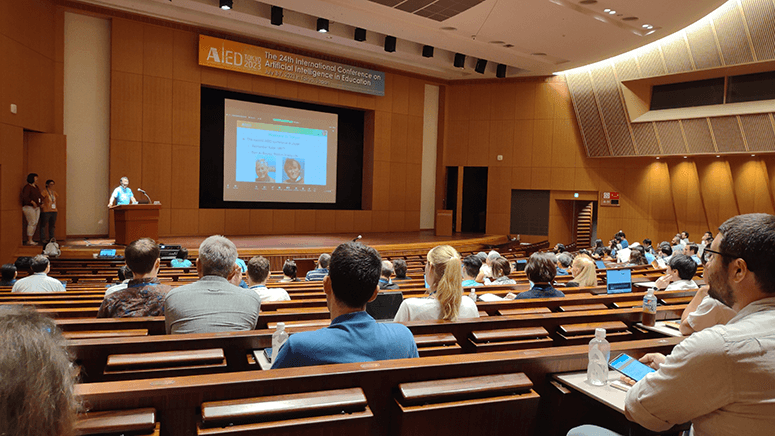The truth about using AI in schools
Despite a literacy rate of 99%, the Philippines has ranked near the bottom of international math, science, and English tests since 1995. As part of the response to this crisis, the Philippines’ public and private sectors have invested in information and communication technologies (ICTs)—computers, the Internet, robotics, and tablets—to transform the design and delivery of education and to improve educational outcomes. Artificial intelligence (AI) is the next technology that schools are poised to try.
AI is a field of study in which computer systems are built to perform functions that are usually associated with human beings, like recognizing faces or speech, playing chess, or driving a vehicle through traffic. When applied in educational contexts, AI in Education (AIED) refers to the use of AI to improve teaching, learning, or the learning experience.

In the annual AIED conference held in Tokyo in July 2023, 500 scholars demonstrated their most recent work, all illustrations of how AI is education’s ally. Classic applications of AIED include one-on-one tutoring systems that help students with their math homework, offering context-aware hints. Some optimize the sequence of practice items to ensure that the difficulty level of the problems is in the Goldilocks zone—not too easy, not too hard. There were examples of virtual mentors: after students type in their questions, the system selects an appropriate response from a library of video recordings. A number of studies investigated how AI could be used to generate pedagogically-effective exam questions. At least one of these systems performed at a level equal to that of human instructors. Automated essay scoring systems could judge not just grammar, but also the logical and argumentative structure of student submissions.
Beyond aiding with student cognition, the AIED community also has a great interest in how students behave and feel. Some researchers fine-tuned facial recognition software to detect more accurately academic emotions such as boredom, confusion, and frustration. A study on help-seeking behaviors found a positive relationship between help acceptance and learning. However, students who asked for more help than others also exhibited more confusion and anxiety.
“There are many factors that inhibit the Philippines from using AI to address our educational ills.”
The good news is that these interventions actually work. Studies have shown that AIED has positive effects on student achievement in general and is particularly effective at helping low achievers. The bad news is that there are many factors that inhibit the Philippines from using AI to address our educational ills. In order to take root, AI requires an ecosystem. It requires computers. Despite the widespread distribution of computers that began in the late 1990s, school and student needs have far outstripped available resources. The number of computers in schools has not yet reached the critical mass needed to give all students substantial computer time. Many AI technologies require Internet access, and only an estimated 1.8% of public schools have free WiFi as of 2022.
AI technologies need to be integrated into the curriculum. However, the curriculum, as it is implemented, tends to treat ICTs as subjects in themselves. Students are taught computer literacy, productivity tools, and programming. ICTs are generally not used as tools to teach other subjects. While AI can be used to teach about computers, this application is quite narrow—AI can do more. AI also needs teacher buy-in, and to achieve that, AI applications must have clear ties with the curriculum. AI applications should not generate additional work. They should be trustworthy. They should come with support systems that teachers can access for help.

Finally, there is the issue of algorithmic bias. Most of these applications are created in Western countries and therefore the data used to train the models underlying these systems come from Western students. Ignoring the effects of cultural factors can decrease an intervention’s effectiveness on a target group. For example, most systems are designed for one-on-one instruction and do not transfer well to contexts that tend to be more collaborative.
Still, there is hope. Two trends are emerging that work to our benefit. First, there is an increasing interest in greater diversity and inclusion in AIED. There is a growing consciousness about how our AIED systems may further marginalize those of a certain race, status, or income level, and a desire to prevent a “Matthew Effect” or accumulated (dis)advantage, where those are already (dis)advantaged become more (dis)advantaged over time.
“AI applications should not generate additional work. They should be trustworthy. They should come with support systems that teachers can access for help.”
Second, the "AIED Unplugged" sentiment is gaining traction. This is an approach to creating AI-based educational technologies that do not demand changes to under-resourced educational ecosystems. They do not require additional hardware, stable Internet access, or sophisticated ICT skills. One example of such a system is an essay-scoring application developed in Brazil. Students write their essays on paper. The teacher takes a photo of the essays. When an Internet connection is available, the photos are uploaded to a server that assesses the essays according to the teacher’s rubric.
I have been a member of the International AIED Society since 2007 and have been on the Society’s Executive Committee since 2019. Yes, I have drunk the Kool-Aid and am (guardedly) optimistic about AIED. AIED will do great things for and with our teachers and students. The challenge is for us human beings to create appropriate AIED tools and deploy them with both intelligence and wisdom.


